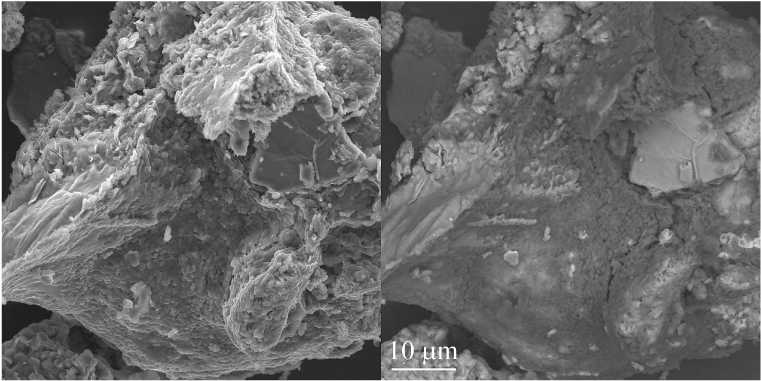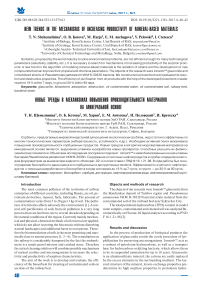Новые тренды в механизмах повышения производительности материалов на минеральной основе
Автор: Щемелинина Т.Н., Котова О.Б., Хария М., Анчугова Е.М., Пеловский И., Кретеску И.
Журнал: Вестник геонаук @vestnik-geo
Рубрика: Научные статьи
Статья в выпуске: 6 (270), 2017 года.
Бесплатный доступ
Сорбенты, предлагаемые мировой индустрией для решения экологических проблем, недостаточно эффективны по многим технологическим параметрам (избирательность, устойчивость и др.). Необходим активный поиск механизмов повышения производительности сорбционных продуктов. Новым трендом в алгоритме моделирования материалов на минеральной основе является выделение штаммов и разработка новых препаратов, способных улучшить их физико-химические показатели. Объектами исследования послужили глауконит Ionsorb™ и иммобилизованные на нем штаммы бактерий Pseudomonas yamanorum VKM В-3033D. Содержание остаточных нефтепродуктов в пробах определяли методом флуориметрии на анализаторе жидкости «Флюорат-02» в соответствии с ПНД Ф 16.1.21-98. В ходе работы был сконструирован биосорбент и дана оценка его сорбционных и деструктивных свойств. Эффективность очистки от нефтепродуктов с помощью разработанного биосорбента в воде составила до 19 % за 7 суток, в грунте - до 30 % за 90 суток.
Глауконит, биосорбент, сорбция, деструкция, нефтезагрязненная вода, нефтезагрязненный грунт, штамм бактерий
Короткий адрес: https://sciup.org/149128700
IDR: 149128700 | УДК: 549.08:628.544:552.123:579.63 | DOI: 10.19110/2221-1381-2017-6-40-42
Текст научной статьи Новые тренды в механизмах повышения производительности материалов на минеральной основе
The most common polluters of the territories of railway enterprises of different countries, including Russia, are oil, petroleum derivatives, masout, fuels, lubricants. The amount of contamination varies from 5 to 20 g per 1 kg of soil. The pollution of territories affects adversely the environment [1]. A natural self-purification of soils from oil pollution is a very long process that can last from one to several decades depending on the natural conditions of the region. Currently mainly mechanical and physical-chemical methods of oil removal are applied, which do not allow restoring the biocenosis without disturbing natural landscapes and additional harm to ecosystems. Therefore the bioremediation of soils is the most promising and maximally close to natural processes [1, 3—6]. The remediation on the railway is considerably hampered by the fact the embankment is a sandy-gravel mixture and crushed stone. Therefore the actual cleaning solution will combine possible mechanisms of natural zeolites and microorganisms to increase the selectivity and productivity of sorption characteristics.
The aim of the work is to develop and evaluate the efficiency of the biosorbent for cleaning of contaminated soils on sections of the railway bed.
Objects and methods of research
The objects of our research were Ionsorb™ glauconite from the Bondarskoe deposit of Tambov region and Pseudomonas yamanorum VKM B-3033D bacterial strain isolated from the contaminated soil of the railroad bed near Syktyvkar City.
The total petroleum hydrocarbon (TPH) content in model water samples, contaminated and cleaned soil was analyzed fluorometrically on Fluorat-02 liquid analyzer according to PND F 16.1.21-98 [2].
Results and discussion
In the process of production of biological products the application of glauconite avoids the costly procedure of lyophilization for preserving microorganisms. Ionsorb™ acts as a sorbent of petroleum hydrocarbons, as well as a transport base for hydrocarbon-oxidizing bacteria, which allows them to be in suspended animation for up to 10 years. Glauconite is an aluminosilicate mineral, the cations are easily replaced by the excess elements in the surrounding medium. The layered structure of the mineral, its ion-exchange properties predetermine its high sorption properties to petroleum hydro- carbons, radionuclides and toxic elements. The ability of Ion-sorb™ to deposit water and low desorption rate immobilize the microorganisms and their metabolites on its surface. At that the rate of chemical bound reaction is such that the glauconite is able to bind pollutants for a short time, and the microbial community can conveniently utilize them. Another advantage of Ionsorb™ is that it increases the diffusion of oxygen and moisture in the soil, which provides optimal water, gas-air and thermal conditions for the growth of immobilized microorganisms. The activity of metabolic enzymes and the energy of all biochemical processes increase significantly. Since Ionsorb™ is a mineral fertilizer itself, it is not necessary to recycle biosorbent spent.
Constructing a biosorbent
The strain of P. yamanorum bacteria was grown in a bioreactor for 3—5 days under conditions of liquid phase fermentation at a temperature of 15—25 °C until a cell titer of 109 CFU/ cm3 was achieved on a medium of the following composition: per 1000 cm3 of water: peptone — 15 g; NaCl — 3.0 g; KCl — 1.0 g; MgSO 4 x 7H 2 O — 0.5 g. The spray application of the strain on the sorbent was then carried out and dried at a temperature of 30—35 °C.
The composition of the biosorbent: glauconite — 85— 90 %, strain of P. yamanorum bacteria — 10—15 %.
To assess the efficiency of adsorption immobilization, the samples were analyzed with a scanning electron microscope VEGA3 TESCAN, x 5000 (see Figure 1).
Estimation of sorption and destructive properties of the bio sorbent in a model water.
To study the sorption and hydrocarbon oxidation properties of the biosorbent obtained we performed an experiment with model water in the presence of crude oil and waste oil. For 1000 cm3 water we added: NaNO3 — 5.0 g; KÍ2ÐÎ4 — 3.0 g; KCl — 0.5 g; MgSO 4 x 5H 2 O — 0.5 g; 100 cm3 of the solution was poured into 250 cm3 flasks, autoclaved for 20 minutes, cooled to the room temperature. 0.5 g of crude oil or waste oil and 1 g of biosorbent were added to the flasks. In the reference variant the biosorbent was not added. The flasks were exposed in a shaker (220 rpm) for 7 days under normal conditions. After 7 days the content of residual oil products was determined in the samples.
As can be seen from Table 1, when the biosorbent is added, the concentration of oil products is significantly decreased (p < 0.05), in a contaminated medium by 13 %, in an oil-polluted medium — by 19 %, and these results indicate that the developed biosorbent possesses sorption and oil destructive properties and is suitable for further researches and model experiments on cleaning of contaminated soils.
Estimation of oil-oxidizing properties of the biosorbent in an oil-contaminated soil from the railway bed.
To study the possibility of application of the biosorbent developed to clean the contaminated soil of the railway bed, the laboratory simulation of the process was carried out. Strongly waste oil contaminated sand-gravel mixture (SGM) was taken from the section of the railway bed. Biosorbent with miner-

Ionsorb ™ surface with immobilized cells of strain Pseudomonas yamanorum VKM B-3033D.
The sample was microscopyed with Scanning Electron Microscope Tescan Vega 3 LMH. (operator Tropnikov E.M.)
Èññëåäîâàíèå ñîñòîÿíèÿ ïîâåðõíîñòè ïðîâîäèëè ñ ïîìîùüþ ñêàíèðóþùåãî ýëåêòðîííîãî ìèêðîñêîïà Tescan Vega 3 LMH (îïåðàòîð Å. Ì. Òðîïíèêîâ)
Table 1
TPH content in water samples after the application of biosorbent, mg/g
Òàáëèöà 1
Изменение концентрации нефтепродуктов в образцах воды в присутствии биосорбента, мг/г
|
Variant |
TPH content in samples after exposition, mg |
|
Reference (water medium + waste oil) |
431.0 ± 13.61 |
|
Medium + 0.1 g waste oil + 1 g biosorbent |
375.0 ± 5.00* |
Список литературы Новые тренды в механизмах повышения производительности материалов на минеральной основе
- Zubrev N. I., Sharpova N. A. Okhrana okruzhaiushchei sredy i ekologicheskaia bezopasnost‘ na zheleznodorozhnom transporte (Environmental protection and environmental safety in railway transport). Moscow: UMK MPS of Russia 1999, 592 pp.
- Metodika vypolneniia izmerenii massovoi doli nefteproduktov v probakh pochv na analizatore zhidkosti «Fliuorat-02». (Methods of performing measurements of the mass fraction of petroleum products in soil samples on a Fluorat-02 fluid analyzer). Institute of Biology of Komi SC UB RAS, Moscow, 1998, 15 pp.
- Nazarenko M. D., Romanova K. N., Lobanov V. G. Sposob vosstanovleniia neftezagriaznennykh pochv i gruntov (Method for the restoration of oil-contaminated soils and soils). Fundamentalnye issledovaniia, 2006, No. 8, pp. 32-33.
- Rogozina E. A., Shimansky V. K. Nekotorye teoreticheskie aspekty vosstanovleniia neftezagriaznennykh pochvennykh ekosistem (Some theoretical aspects of the restoration of oil-contaminated soil ecosystems). Neftegazovaya Geologiya. Theory and practice, 2007, V. 2, 16 pp.
- Kotova O. B., Harja M., Cretescu I., Noli F., Pelovski Y., Shushkov D. A. Zeolites in technologies of pollution prevention and remediation of aquation systems//Vestnik of Institute of Geology of Komi Sience Center of Ural Branch RAS. 2017. No 5. pp. 49-53. ( ) DOI: 10.19110/2221-1381-2017-5-49-53
- Soprunova O. B. Mikrobnye biotekhnologii remediatcii (ochistka) pochv, zagriaznennykh neftiu i nefteproduktami na territorii Atyrauskoi oblasti (Microbial biotechnologies of remediation (cleaning) of soils polluted with oil and oil products in the territory of Atyrau region). Molodoy ucheny, 2014, No. 20, pp. 41-43.


